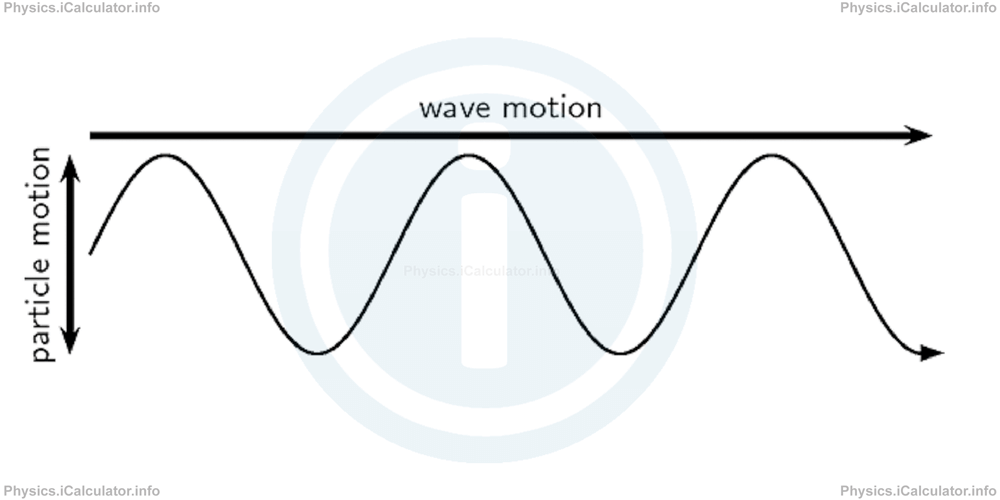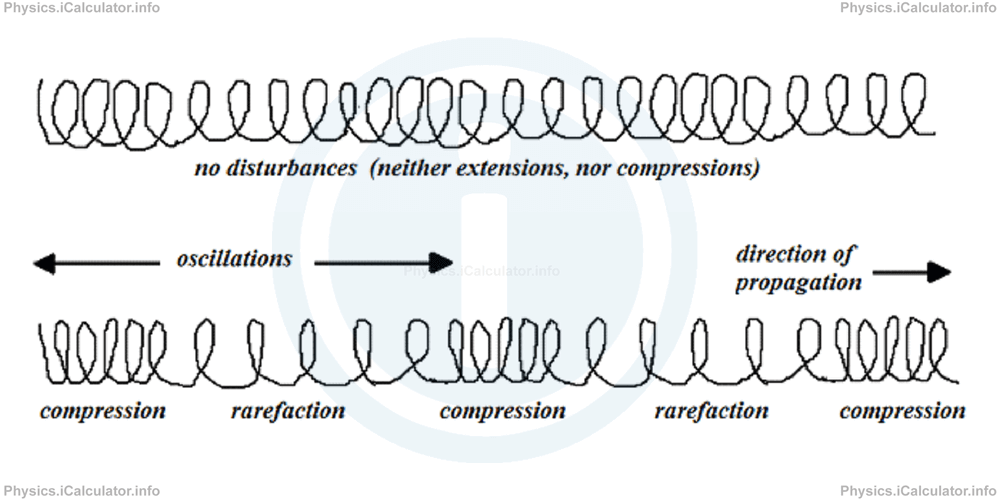Menu
Physics Lesson 11.1.3 - Classification of Waves
Please provide a rating, it takes seconds and helps us to keep this resource free for all to use
Welcome to our Physics lesson on Classification of Waves, this is the third lesson of our suite of physics lessons covering the topic of Types of Waves. The Simplified Equation of Waves, you can find links to the other lessons within this tutorial and access additional physics learning resources below this lesson.
Classification of Waves
Waves are classified in two groups based on two different criteria. They are:
I. According to the method of propagation
When waves' motion is perpendicular to particles' motion as shown below,

waves are known as "transverse". This means amplitude is perpendicular to wavelength (A ┴ λ). Water waves, rope waves and light waves are some examples of transverse waves in daily life.
Some other waves propagate in the same direction in which the oscillations occur. In these cases, there are many successive compressions and rarefactions of medium as shown in the figure below.

In the first figure, no waves are produced in the spring. As a result, all turns have the same distance from each other.
In the second figure, we see compressions and rarefactions occurring in the spring because of a disturbance. As a result, linear waves known as "longitudinal" are produced in the spring. The spring here acts as medium of waves propagation.
Sound waves, spring waves etc., are examples of longitudinal waves. In such waves, amplitude is in the same direction of waves' propagation (they are parallel). Thus, A || λ.
II. According to the medium of propagation
Some waves need a material medium to propagate. Otherwise, they cannot exist. Such waves are known as "mechanical waves". For example, sound is a mechanical wave as it needs a material medium such as air, metals, wood etc. to propagate. No sound waves exist in vacuum. Also rope waves, water waves, etc. are all examples of mechanical waves.
On the other hand, there are other waves which do not need any material medium to propagate. These waves can also propagate in vacuum and are known as "electromagnetic waves" (in short, EM). Light waves are the most common example of EM waves.
Thus, for example water waves are mechanical and transverse because they need a material medium (water) to propagate and the direction of oscillations is perpendicular to the direction of propagation. On the other hand, sound waves are mechanical and longitudinal waves as they also need a material medium to propagate but their amplitude is parallel to the direction of oscillations.
You have reached the end of Physics lesson 11.1.3 Classification of Waves. There are 4 lessons in this physics tutorial covering Types of Waves. The Simplified Equation of Waves, you can access all the lessons from this tutorial below.
More Types of Waves. The Simplified Equation of Waves Lessons and Learning Resources
Whats next?
Enjoy the "Classification of Waves" physics lesson? People who liked the "Types of Waves. The Simplified Equation of Waves lesson found the following resources useful:
- Classification Feedback. Helps other - Leave a rating for this classification (see below)
- Waves Physics tutorial: Types of Waves. The Simplified Equation of Waves. Read the Types of Waves. The Simplified Equation of Waves physics tutorial and build your physics knowledge of Waves
- Waves Revision Notes: Types of Waves. The Simplified Equation of Waves. Print the notes so you can revise the key points covered in the physics tutorial for Types of Waves. The Simplified Equation of Waves
- Waves Practice Questions: Types of Waves. The Simplified Equation of Waves. Test and improve your knowledge of Types of Waves. The Simplified Equation of Waves with example questins and answers
- Check your calculations for Waves questions with our excellent Waves calculators which contain full equations and calculations clearly displayed line by line. See the Waves Calculators by iCalculator™ below.
- Continuing learning waves - read our next physics tutorial: General Equation of Waves
Help others Learning Physics just like you
Please provide a rating, it takes seconds and helps us to keep this resource free for all to use
We hope you found this Physics lesson "Types of Waves. The Simplified Equation of Waves" useful. If you did it would be great if you could spare the time to rate this physics lesson (simply click on the number of stars that match your assessment of this physics learning aide) and/or share on social media, this helps us identify popular tutorials and calculators and expand our free learning resources to support our users around the world have free access to expand their knowledge of physics and other disciplines.